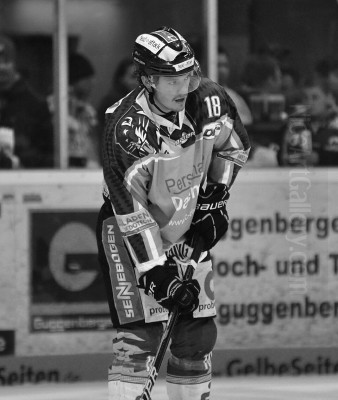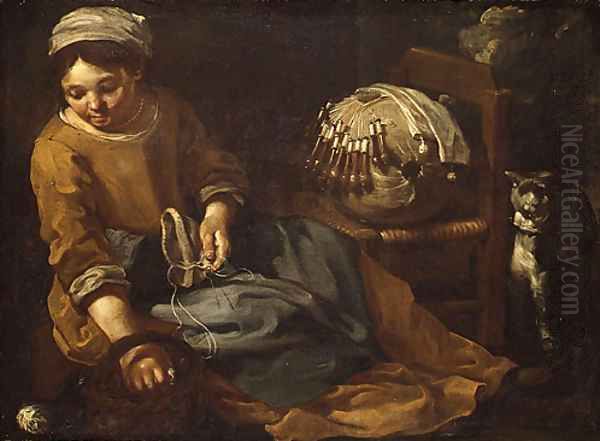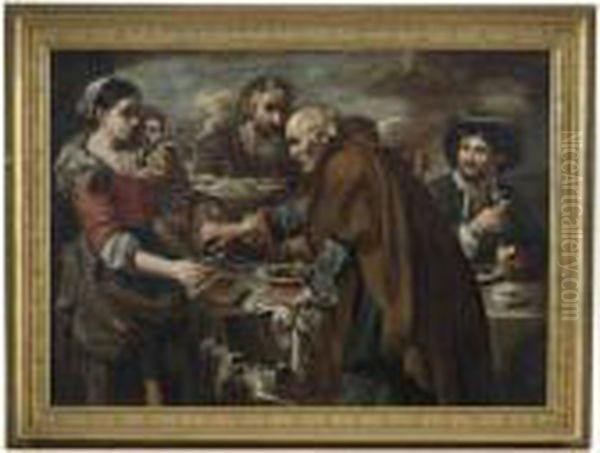
Bernhard Keil, also widely known by his Italian moniker Monsù Bernardo, stands as a fascinating figure in the landscape of 17th-century European art. Born in Helsingør, Denmark, in 1624, Keil embarked on a journey that took him from the northern reaches of Europe to the vibrant artistic heart of Italy, where he spent the majority of his productive career. His life and work offer a compelling study in artistic migration, stylistic synthesis, and the transmission of knowledge between the Dutch Golden Age and the Italian Baroque. He died in Rome in 1687, leaving behind a body of work primarily characterized by genre scenes imbued with allegorical depth.
Early Life and Artistic Formation
Bernhard Keil's artistic journey began in his native Denmark. Born in Helsingør, a town known in English literature as Elsinore, he received his initial artistic training likely in Copenhagen under the court painter Maarten van Steenwinckel. This early grounding would have exposed him to the prevailing trends in Northern European art. However, seeking broader horizons and more advanced instruction, Keil made a pivotal move in his late teens.
Around 1642, Keil traveled to Amsterdam, the bustling metropolis that was then the epicenter of the Dutch Golden Age of painting. This move was crucial, as it led him to the studio of one of the era's towering figures: Rembrandt van Rijn. For approximately two years, from 1642 to 1644, Keil worked and studied under the master's tutelage. This period placed him directly within one of the most innovative and influential workshops in Europe, alongside other talented pupils who absorbed Rembrandt's techniques and approach, such as Govert Flinck and Ferdinand Bol, although their time might not have directly overlapped significantly.

Interestingly, despite this direct exposure to Rembrandt's powerful style, characterized by dramatic chiaroscuro, psychological depth, and expressive brushwork, Keil's own mature work shows relatively little direct stylistic imitation of his master. While the training undoubtedly honed his technical skills and understanding of light and shadow, Keil would forge a distinct artistic identity, particularly after his move to Italy. His time in Amsterdam, however, was formative, not just for the skills acquired but also for the connections made, potentially through Rembrandt's network or his dealer, Hendrick Uylenburgh.
The Italian Journey: Venice, Bergamo, Ravenna, and Rome
Following his formative years in the Netherlands, Keil's ambition drew him south. In 1651, he embarked on the journey to Italy, a destination that attracted countless Northern European artists seeking inspiration from classical antiquity and the masters of the Italian Renaissance and Baroque. His first significant stop appears to have been Venice, the city famed for its colorito tradition championed by artists like Titian and Tintoretto in the previous century, and closer to his time, by figures whose work might have resonated with his developing style.
Keil did not remain in Venice permanently. His talents soon found patronage elsewhere. Records indicate he spent time working in Bergamo, a city within the Venetian sphere of influence, and later in Ravenna. During this period, he began to establish his reputation, likely securing commissions that allowed him to support himself and develop his artistic practice further. An important early patron mentioned is Senator Giovanni Carlo Savorgnan, possibly commissioning works during Keil's time in or near Venice.
The decisive move came in 1656 when Keil settled in Rome. The Eternal City was the undisputed capital of the Baroque art world, dominated by giants like Gian Lorenzo Bernini in sculpture and architecture, and painters such as Pietro da Cortona, whose grand ceiling frescoes defined the High Baroque style. While Keil did not engage in such monumental projects, Rome offered a rich environment of patronage, artistic exchange, and inspiration. He quickly found success, securing commissions, particularly from high-ranking church officials, and became a permanent resident, living and working there until his death in 1687.
Artistic Style and Thematic Focus
Bernhard Keil carved a distinct niche for himself within the Italian art scene, focusing primarily on genre painting, often infused with allegorical meaning. His style represents a unique synthesis of his Northern European training and the influences he absorbed in Italy. A hallmark of his work is a pronounced use of chiaroscuro – strong contrasts between light and shadow – which, while a feature of Rembrandt's work, Keil adapted to his own ends, often creating intimate, warmly lit scenes.

His subject matter frequently revolved around depictions of everyday life, but elevated through allegorical intent. He became particularly known for series representing the Five Senses, the Four Seasons, and the Four Elements. These themes allowed him to explore human experience and the natural world through relatable figures and settings. Keil often populated these scenes with elderly men and women, or young children, typically dressed in simple, sometimes worn or tattered, clothing. This focus on humble figures lent his work a sense of realism and pathos, distinguishing it from the more idealized or heroic subjects often favored in Italian history painting.
While trained by Rembrandt, Keil's mature style shows a stronger affinity with certain aspects of the Venetian school and the works of artists influenced by Caravaggio's naturalism, albeit tempered. Notably, his time in Italy exposed him to the works of Domenico Fetti, a painter active in Mantua and Venice whose small-scale biblical and genre scenes, characterized by fluid brushwork and rich color, seem to have resonated with Keil. This influence is visible in the warmth of Keil's palette and his handling of paint, which, while retaining a certain Northern precision, also embraces a more painterly quality suited to his Italian context. He rarely painted pure landscapes, keeping the focus firmly on the human figure.
Compared to the often boisterous scenes of Dutch and Flemish genre painters like Adriaen Brouwer or Jan Steen, or the low-life focus of the Bamboccianti (Northern artists in Rome led by Pieter van Laer), Keil's work often possesses a quieter, more contemplative mood. His figures, even when representing abstract concepts like the senses or seasons, are rendered with empathy and dignity. This blend of Northern realism, Italianate light and warmth, and allegorical depth defines his unique contribution.
Representative Works and Oeuvre
Several key works exemplify Bernhard Keil's artistic output and thematic preoccupations. One of his most recognized paintings is The Lacemaker, dated around 1665 and now housed in the Metropolitan Museum of Art, New York. This work showcases his skill in depicting intimate domestic scenes, focusing on the quiet concentration of the subject, rendered with characteristic warmth and attention to texture. The play of light on the figure and her work is handled with sensitivity, creating a scene of gentle dignity.
Keil's fondness for allegorical series is well-documented. Sets of paintings representing The Four Seasons appear recurrently in discussions of his work. These often feature figures embodying each season through their age, activity, or associated produce. For instance, Winter might be depicted as an old man warming himself by a fire, while Summer could be a youth surrounded by harvest bounty. Such series were popular in the Baroque period, and Keil's interpretations are noted for their sympathetic portrayal of the human condition across the cycle of life and nature. Auction records mention sets like "LE STAGIONI" and "THE SEASONS," with significant estimated values (e.g., €25,000-€35,000), indicating their desirability.
Another known work is Fire by the Hearth, a painting donated by the Wachtmeister family to the city of Gothenburg in 1981. This title suggests a theme close to his common repertoire – intimate, warmly lit interior scenes, often featuring elderly figures finding comfort or engaging in simple tasks. Such works highlight his ability to capture atmosphere and convey emotion through light and posture.
His oeuvre also includes numerous depictions of peasants, shepherds, and sleeping children. These subjects allowed him to explore themes of innocence, labor, and repose, often rendered in half-length or bust-length formats that focus attention on the figure's expression and character. Additionally, a series of small, circular paintings (tondi) are mentioned, possibly created for his early patron Giovanni Carlo Savorgnan in the Veneto region. These varied works collectively demonstrate Keil's consistent interest in human subjects drawn from everyday life, elevated by his skillful technique and often imbued with deeper meaning.
Connections, Influence, and Historical Record
Beyond his own artistic production, Bernhard Keil holds a specific place in art history due to his connection with Rembrandt and his role as an informant for a prominent art historian. Having spent time in Rembrandt's studio, Keil became a source of information about the Dutch master for the Florentine writer and connoisseur Filippo Baldinucci. Baldinucci was compiling his Cominciamento e progresso dell'arte dell'intagliare in rame, a history of engraving, which included a section on Rembrandt.
Keil provided Baldinucci with details about Rembrandt's life and, crucially, his etching techniques. While some of the biographical information passed on by Keil has been questioned by later scholars or considered potentially embellished, his insights into Rembrandt's printmaking methods are considered valuable. When corroborated with other sources, Keil's testimony, filtered through Baldinucci, contributes significantly to our understanding of how Rembrandt achieved his revolutionary effects in etching. This connection underscores the flow of artistic knowledge across Europe in the 17th century.
Keil's network also extended through his early association with Rembrandt's circle. The dealer Hendrick Uylenburgh, a key figure in Amsterdam's art market who managed a large workshop and dealt in Rembrandt's work, likely provided Keil with introductions. Through such connections, Keil may have encountered other artists associated with Rembrandt or Uylenburgh's enterprise, such as Bernard van den Broeck and Pieter van der Eeckhout, further embedding him within the artistic currents of his time before his departure for Italy.
In Italy, his success is evidenced by his ability to secure patronage from influential figures, including church officials and members of the aristocracy like Senator Savorgnan. This indicates his skill in navigating the complex social and artistic hierarchies of Baroque Italy, adapting his Northern sensibilities to appeal to Italian tastes while retaining his unique artistic voice. He stands alongside other Northern artists who found success in Italy, such as the Caravaggist Matthias Stom or the earlier German painter Adam Elsheimer, who similarly brought a distinct perspective to the Italian scene.
Legacy and Reception
Bernhard Keil, or Monsù Bernardo, occupies a respected, if specialized, position in the history of Baroque art. As a Danish artist who achieved significant success abroad, particularly in Italy, he exemplifies the transnational nature of European art in the 17th century. His ability to synthesize his Northern training – including the invaluable, if stylistically indirect, experience in Rembrandt's studio – with the influences of Italian painting, especially the Venetian school and the legacy of Caravaggism, resulted in a distinctive and appealing body of work.
His focus on genre scenes imbued with allegory, often featuring humble or elderly figures rendered with warmth and dignity, offered a unique contribution to the Italian art scene, differing from both the grand manner of High Baroque history painting and the lower-life focus of some other genre specialists. His technical skill, particularly his handling of light and shadow (chiaroscuro) and his warm palette, earned him considerable recognition during his lifetime, evidenced by his sustained patronage in Rome.
His legacy is twofold: firstly, through his paintings, which continue to be appreciated for their technical quality, emotional resonance, and unique blend of styles. Works like The Lacemaker and his allegorical series remain compelling examples of Baroque genre painting. Secondly, his historical importance is cemented by his role as a conduit of information about Rembrandt's techniques, as recorded by Filippo Baldinucci. This contribution, though indirect, provides valuable insight into the working methods of one of history's greatest artists. The continued presence of Keil's works in museum collections and their performance on the art market attest to his enduring appeal and significance.
Conclusion
Bernhard Keil's life journey from Helsingør to Rome mirrors the path of many Northern artists seeking the light and lessons of Italy. Yet, his artistic trajectory was uniquely his own. Trained in Denmark and crucially, in Rembrandt's Amsterdam studio, he absorbed foundational skills but forged an independent path upon settling in Italy. As Monsù Bernardo, he became a respected master of genre painting, skillfully blending Northern European realism and attention to detail with the warmth, color, and chiaroscuro favored in his adopted homeland. His preference for allegorical themes expressed through everyday figures, particularly the elderly and children, lent his work a distinctive emotional depth and contemplative quality. Remembered both for his sensitive paintings and his role in transmitting knowledge about Rembrandt, Bernhard Keil remains an important figure for understanding the rich artistic exchanges that characterized the European Baroque.